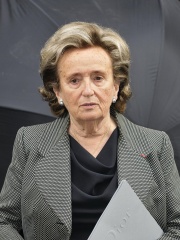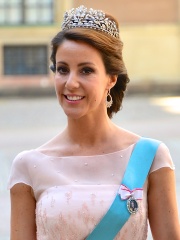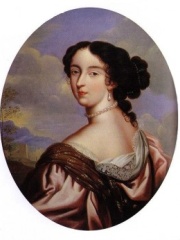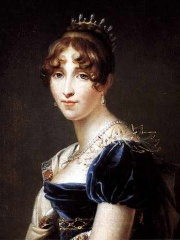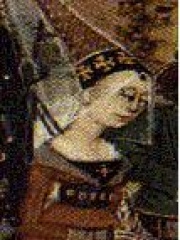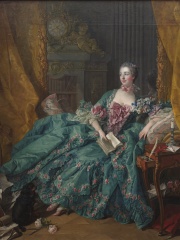
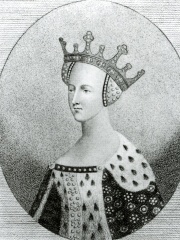
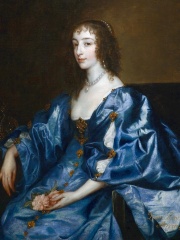
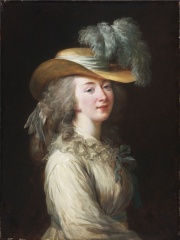
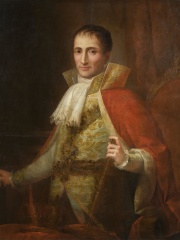

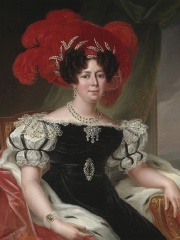
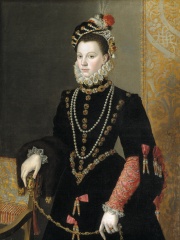
The Most Famous
COMPANIONS from France
This page contains a list of the greatest French Companions. The pantheon dataset contains 784 Companions, 66 of which were born in France. This makes France the birth place of the 2nd most number of Companions.
Top 10
The following people are considered by Pantheon to be the top 10 most legendary French Companions of all time. This list of famous French Companions is sorted by HPI (Historical Popularity Index), a metric that aggregates information on a biography's online popularity. Visit the rankings page to view the entire list of French Companions.

1. Madame de Pompadour (1721 - 1764)
With an HPI of 81.49, Madame de Pompadour is the most famous French Companion. Her biography has been translated into 56 different languages on wikipedia.
Jeanne Antoinette Poisson, Marquise de Pompadour (, French: [pɔ̃paduʁ] ; 29 December 1721 – 15 April 1764), commonly known as Madame de Pompadour, was a member of the French court. She was the official chief mistress of King Louis XV from 1745 to 1751, and remained influential as court favourite until her death. Pompadour took charge of the king's schedule and was a valued aide and advisor, despite her frail health and many political enemies. She secured titles of nobility for herself and her relatives, and built a network of clients and supporters. She was particularly careful not to alienate the popular Queen, Marie Leszczyńska. On 8 February 1756, the Marquise de Pompadour was named as the thirteenth lady-in-waiting to the queen, a position considered the most prestigious at the court, which accorded her with honors. Pompadour was a major patron of architecture and decorative arts, especially porcelain. She was a patron of the philosophes of the Enlightenment, including Voltaire. Hostile critics at the time generally tarred her as a malevolent political influence, but historians are more favorable, emphasizing her successes as a patron of the arts and a champion of French pride. Modern historians suggest that the critics of Pompadour were driven by fears over the overturning of the existing hierarchies that Pompadour's power and influence represented, as a woman who was not born into the aristocracy.

2. Catherine of Valois (1401 - 1437)
With an HPI of 80.98, Catherine of Valois is the 2nd most famous French Companion. Her biography has been translated into 45 different languages.
Catherine of Valois or Catherine of France (27 October 1401 – 3 January 1437) was Queen of England from 1420 until 1422. A daughter of King Charles VI of France, she married King Henry V of England and was the mother of King Henry VI. Catherine's marriage was part of a plan to eventually place Henry V on the throne of France, and perhaps end what is now known as the Hundred Years' War. But, although her son Henry VI was later crowned in Paris, the war continued. After Henry V's death, Catherine's unexpected marriage to Sir Owen Tudor helped lead to the rise of the House of Tudor's fortunes and to her Tudor grandson's eventual elevation to the throne as King Henry VII of England.

3. Henrietta Maria of France (1609 - 1669)
With an HPI of 79.54, Henrietta Maria of France is the 3rd most famous French Companion. Her biography has been translated into 49 different languages.
Henrietta Maria of France (French: Henriette Marie; 25 November 1609 – 10 September 1669) was Queen of England, Scotland and Ireland from her marriage to King Charles I on 13 June 1625 until his execution on 30 January 1649. She was the mother of Charles II and James II and VII. Under a decree of her husband, she was known in England as Queen Mary, but she did not like this name and signed her letters "Henriette" or "Henriette Marie". Henrietta Maria's Roman Catholicism made her unpopular in England, and also prohibited her from being crowned in a Church of England service; therefore, she never had a coronation. She immersed herself in national affairs as civil war loomed, and in 1644, following the birth of her youngest daughter, Henrietta, during the height of the First English Civil War, was compelled to seek refuge in France. The execution of Charles I in 1649 left her impoverished. She settled in Paris and returned to England after the Restoration of Charles II to the throne. In 1665, she moved back to Paris, where she died four years later. The North American Province of Maryland, a major haven for Roman Catholic settlers, was named in her honour. The name was carried over into the current U.S. state of Maryland.

4. Madame du Barry (1743 - 1793)
With an HPI of 79.29, Madame du Barry is the 4th most famous French Companion. Her biography has been translated into 45 different languages.
Jeanne Bécu, Comtesse du Barry (French: [baʁi]; 19 August 1743 – 8 December 1793) was the last maîtresse-en-titre of King Louis XV of France. She was executed by guillotine during the French Revolution on accusations of treason—particularly being suspected of assisting émigrés to flee from the Revolution. She is also known as "Mademoiselle Vaubernier" ([vobɛʁnje]). In 1768, when the king wished to make Jeanne maîtresse-en-titre, etiquette required her to be the wife of a high courtier, so she was hastily married on 1 September 1768 to Comte Guillaume du Barry. The wedding ceremony was accompanied by a false birth certificate created by Jean-Baptiste du Barry, the comte's older brother. The certificate made Jeanne appear younger by three years and obscured her poor background. Henceforth, she was recognised as the king's official paramour. Her arrival at the French royal court scandalised some, because she had been a courtesan and came from humble beginnings. She was shunned by many including Marie Antoinette, whose contempt for Jeanne caused alarm and dissension at court. On New Year's Day 1772, Marie Antoinette deigned to speak to Jeanne; her remark, "There are many people at Versailles today", was enough to take the edge off the dispute, though many still disapproved of Jeanne. Decades later, during the Reign of Terror in the French Revolution, Jeanne was imprisoned over accusations of treason by her servant Zamor. She was executed by guillotine on 8 December 1793. Her body was buried in the Madeleine Cemetery. The fabulous gems which she had smuggled to London were sold at auction in 1795.

5. Brigitte Macron (b. 1953)
With an HPI of 78.36, Brigitte Macron is the 5th most famous French Companion. Her biography has been translated into 47 different languages.
Brigitte Marie-Claude Macron (French: [bʁiʒit maʁi klod makʁɔ̃]; née Trogneux [tʁɔɲø], previously Auzière [ozjɛːʁ]; born 13 April 1953) is a French former teacher. She is the wife of Emmanuel Macron, who has served as President of France and Co-Prince of Andorra since 2017.

6. Joseph Bonaparte (1768 - 1844)
With an HPI of 78.25, Joseph Bonaparte is the 6th most famous French Companion. His biography has been translated into 66 different languages.
Joseph Bonaparte (born Giuseppe di Buonaparte, Italian: [dʒuˈzɛppe di ˌbwɔnaˈparte]; Corsican: Ghjuseppe Bonaparte; Spanish: José Bonaparte; 7 January 1768 – 28 July 1844), regnal name Joseph I, was a French statesman, lawyer, diplomat and older brother of Napoleon Bonaparte. In 1806, Napoleon made him King of Naples, and then King of Spain and the Indies in 1808. After the fall of Napoleon, Joseph styled himself Comte de Survilliers and emigrated to the United States, where he lived in the Point Breeze estate at Bordentown, New Jersey.

7. Philippa of Hainault (1314 - 1369)
With an HPI of 77.09, Philippa of Hainault is the 7th most famous French Companion. Her biography has been translated into 43 different languages.
Philippa of Hainault (sometimes spelled Hainaut; Middle French: Philippe de Hainaut; 24 June 1310 (or 1315) – 15 August 1369) was Queen of England as the wife and political adviser of King Edward III. She acted as regent in 1346, when her husband was away for the Hundred Years' War. Daughter of William I, Count of Hainaut, and French princess Joan of Valois, Philippa was engaged to Edward, Prince of Wales, in 1326. Their marriage was celebrated in York Minster on 24 January 1328, some months after Edward's accession to the throne of England and Isabella of France's infamous invasion. After her husband reclaimed the throne, Philippa influenced King Edward to take interest in the nation's commercial expansion, was part of the successful Battle of Neville's Cross, and often went on expeditions to Scotland and France. She won much popularity with the English people for her compassion in 1347, when she successfully persuaded the King to spare the lives of the Burghers of Calais. This popularity helped maintain peace in England throughout their long reign.

8. Désirée Clary (1777 - 1860)
With an HPI of 75.69, Désirée Clary is the 8th most famous French Companion. Her biography has been translated into 47 different languages.
Bernardine Eugénie Désirée Clary (Swedish: Eugenia Bernhardina Desideria; 8 November 1777 – 17 December 1860) was Queen of Sweden and Norway from 5 February 1818 to 8 March 1844 as the wife of King Charles XIV John. Charles John was a French general and founder of the House of Bernadotte. Désirée Clary, the mother of Oscar I, was the one-time fiancée of Napoleon Bonaparte. She was also the sister of Julie Clary, the queen consort of Spain and Naples. Her name was officially changed in Sweden to Desideria although she did not use that name.

9. Elisabeth of Valois (1545 - 1568)
With an HPI of 75.56, Elisabeth of Valois is the 9th most famous French Companion. Her biography has been translated into 42 different languages.
Elisabeth of France, or Elisabeth of Valois (Spanish: Isabel de Valois; French: Élisabeth de Valois; 2 April 1546 – 3 October 1568), was Queen of Spain as the third wife of Philip II of Spain. She was the eldest daughter of Henry II of France and Catherine de' Medici.
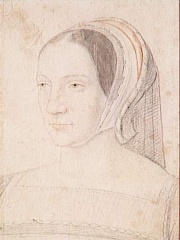
10. Claude of France (1499 - 1524)
With an HPI of 75.32, Claude of France is the 10th most famous French Companion. Her biography has been translated into 42 different languages.
Claude of France (13 October 1499 – 26 July 1524) was Queen of France from 1 January 1515 as the wife of King Francis I and Duchess of Brittany in her own right from 9 January 1514 until her death in 1524. She was the eldest daughter of King Louis XII of France and Duchess Anne of Brittany.
People
Pantheon has 66 people classified as French companions born between 545 and 1976. Of these 66, 4 (6.06%) of them are still alive today. The most famous living French companions include Brigitte Macron, Vanessa Paradis, and Bernadette Chirac. The most famous deceased French companions include Madame de Pompadour, Catherine of Valois, and Henrietta Maria of France.
Living French Companions
Go to all RankingsBrigitte Macron
1953 - Present
HPI: 78.36
Vanessa Paradis
1972 - Present
HPI: 65.78
Bernadette Chirac
1933 - Present
HPI: 63.06
Princess Marie of Denmark
1976 - Present
HPI: 56.18
Deceased French Companions
Go to all RankingsMadame de Pompadour
1721 - 1764
HPI: 81.49
Catherine of Valois
1401 - 1437
HPI: 80.98
Henrietta Maria of France
1609 - 1669
HPI: 79.54
Madame du Barry
1743 - 1793
HPI: 79.29
Joseph Bonaparte
1768 - 1844
HPI: 78.25
Philippa of Hainault
1314 - 1369
HPI: 77.09
Désirée Clary
1777 - 1860
HPI: 75.69
Elisabeth of Valois
1545 - 1568
HPI: 75.56
Claude of France
1499 - 1524
HPI: 75.32
Françoise d'Aubigné, Marquise de Maintenon
1635 - 1719
HPI: 74.90
Hortense de Beauharnais
1783 - 1837
HPI: 74.83
Isabella of France
1295 - 1358
HPI: 74.62
Overlapping Lives
Which Companions were alive at the same time? This visualization shows the lifespans of the 16 most globally memorable Companions since 1700.


